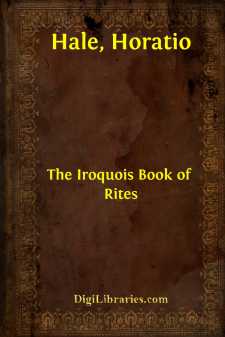Categories
- Antiques & Collectibles 13
- Architecture 36
- Art 48
- Bibles 22
- Biography & Autobiography 813
- Body, Mind & Spirit 142
- Business & Economics 28
- Children's Books 14
- Children's Fiction 11
- Computers 4
- Cooking 94
- Crafts & Hobbies 4
- Drama 346
- Education 46
- Family & Relationships 57
- Fiction 11829
- Games 19
- Gardening 17
- Health & Fitness 34
- History 1377
- House & Home 1
- Humor 147
- Juvenile Fiction 1873
- Juvenile Nonfiction 202
- Language Arts & Disciplines 88
- Law 16
- Literary Collections 686
- Literary Criticism 179
- Mathematics 13
- Medical 41
- Music 40
- Nature 179
- Non-Classifiable 1768
- Performing Arts 7
- Periodicals 1453
- Philosophy 64
- Photography 2
- Poetry 896
- Political Science 203
- Psychology 42
- Reference 154
- Religion 513
- Science 126
- Self-Help 84
- Social Science 81
- Sports & Recreation 34
- Study Aids 3
- Technology & Engineering 59
- Transportation 23
- Travel 463
- True Crime 29
The Iroquois Book of Rites
by: Horatio Hale
Categories:
Description:
Excerpt
CHAPTER I.
THE HURON-IROQUOIS NATIONS.
At the outset of the sixteenth century, when the five tribes or
"nations" of the Iroquois confederacy first became known to European
explorers, they were found occupying the valleys and uplands of northern
New York, in that picturesque and fruitful region which stretches
westward from the head-waters of the Hudson to the Genesee. The Mohawks,
or Caniengas—as they should properly be called—possessed the Mohawk
River, and covered Lake George and Lake Champlain with their flotillas
of large canoes, managed with the boldness and skill which, hereditary
in their descendants, make them still the best boatmen of the North
American rivers. West of the Caniengas the Oneidas held the small river
and lake which bear their name, the first in that series of beautiful
lakes, united by interlacing streams, which seemed to prefigure in the
features of nature the political constitution of the tribes who
possessed them. West of the Oneidas, the imperious Onondagas, the
central and, in some respects, the ruling nation of the League,
possessed the two lakes of Onondaga and Skeneateles, together with the
common outlet of this inland lake system, the Oswego River, to its issue
into Lake Ontario. Still proceeding westward, the lines of trail and
river led to the long and winding stretch of Lake Cayuga, about which
were clustered the towns of the people who gave their name to the lake;
and beyond them, over the wide expanse of hills and dales surrounding
Lakes Seneca and Canandaigua, were scattered the populous villages of
the Senecas, more correctly styled Sonontowanas or Mountaineers. Such
were the names and abodes of the allied nations, members of the
far-famed Kanonsionni, or League of United Households, who were destined
to become for a time the most notable and powerful community among the
native tribes of North America. [Footnote: See Appendix, note A, for the
origin and meaning of the names commonly given to the Iroquois nations.]
The region which has been described was not, however, the original seat
of those nations. They belonged to that linguistic family which is known
to ethnologists as the Huron-Iroquois stock. This stock comprised the
Hurons or Wyandots, the Attiwandaronks or Neutral Nation, the Iroquois,
the Eries, the Andastes or Conestogas, the Tuscaroras, and some smaller
bands. The tribes of this family occupied a long, irregular area of
inland territory, stretching from Canada to North Carolina. The northern
nations were all clustered about the great lakes; the southern bands
held the fertile valleys bordering the head-waters of the rivers which
flowed from the Allegheny mountains. The languages of all these tribes
showed a close affinity. There can be no doubt that their ancestors
formed one body, and, indeed, dwelt at one time (as has been well said
of the ancestors of the IndoEuropean populations), under one roof. There
was a Huron-Iroquois "family-pair," from which all these tribes were
descended. In what part of the world this ancestral household resided is
a question which admits of no reply, except from the merest
conjecture....



